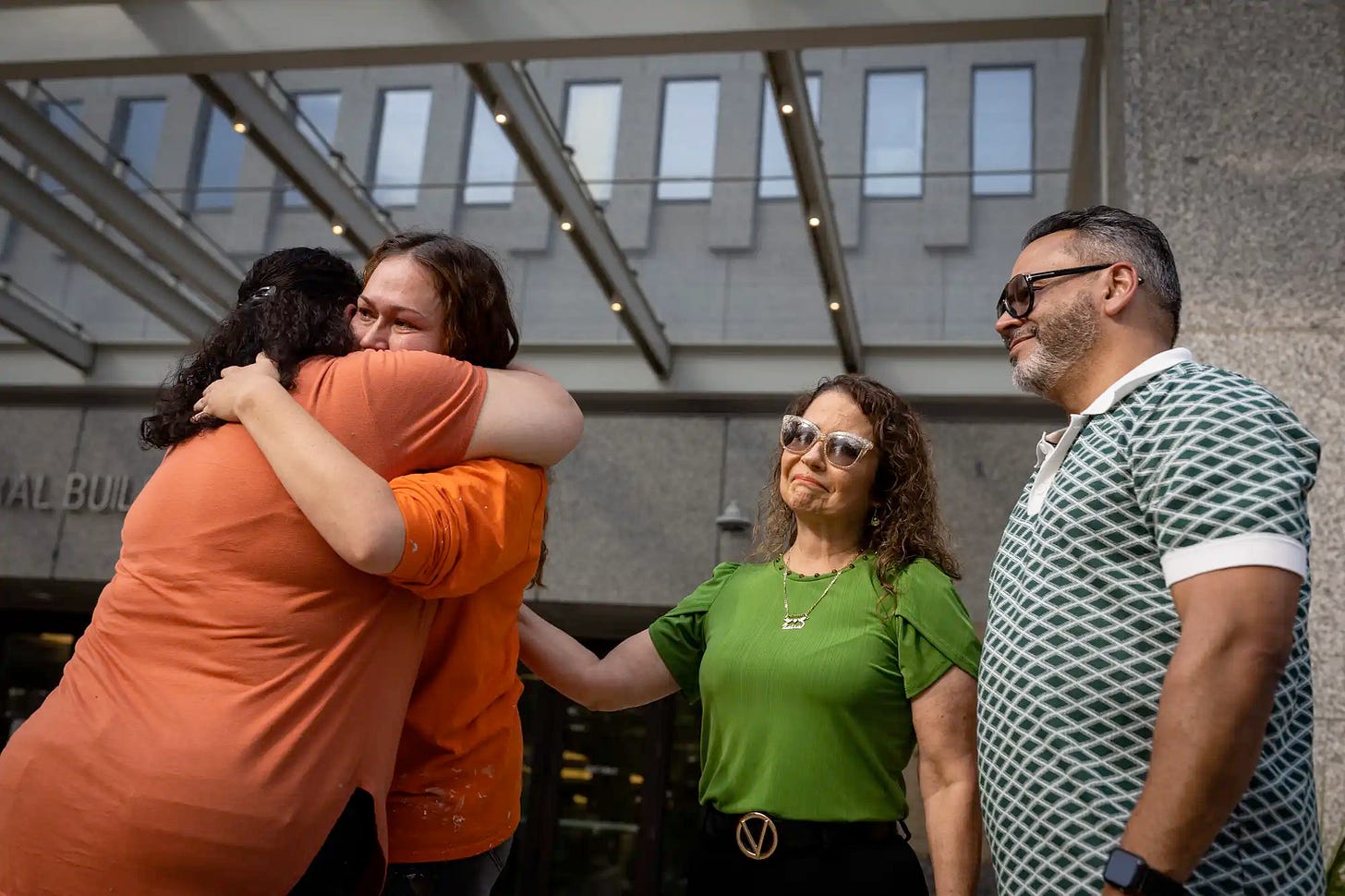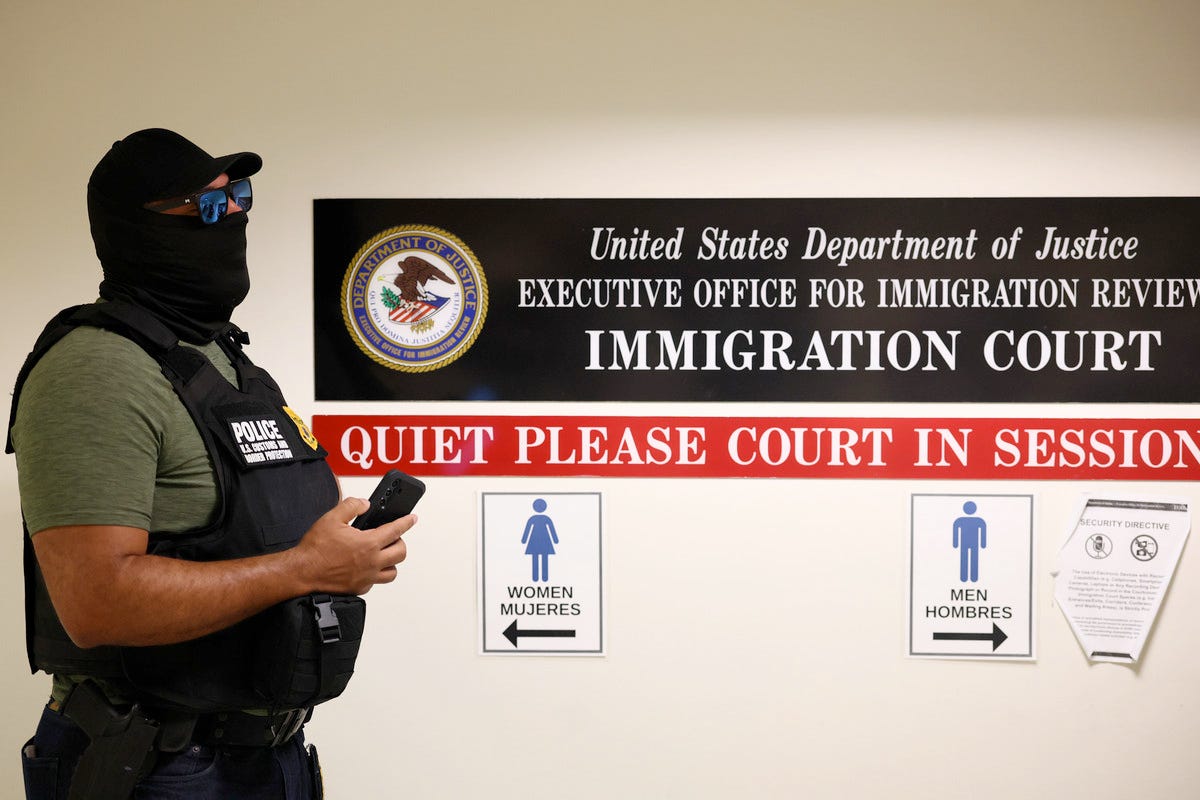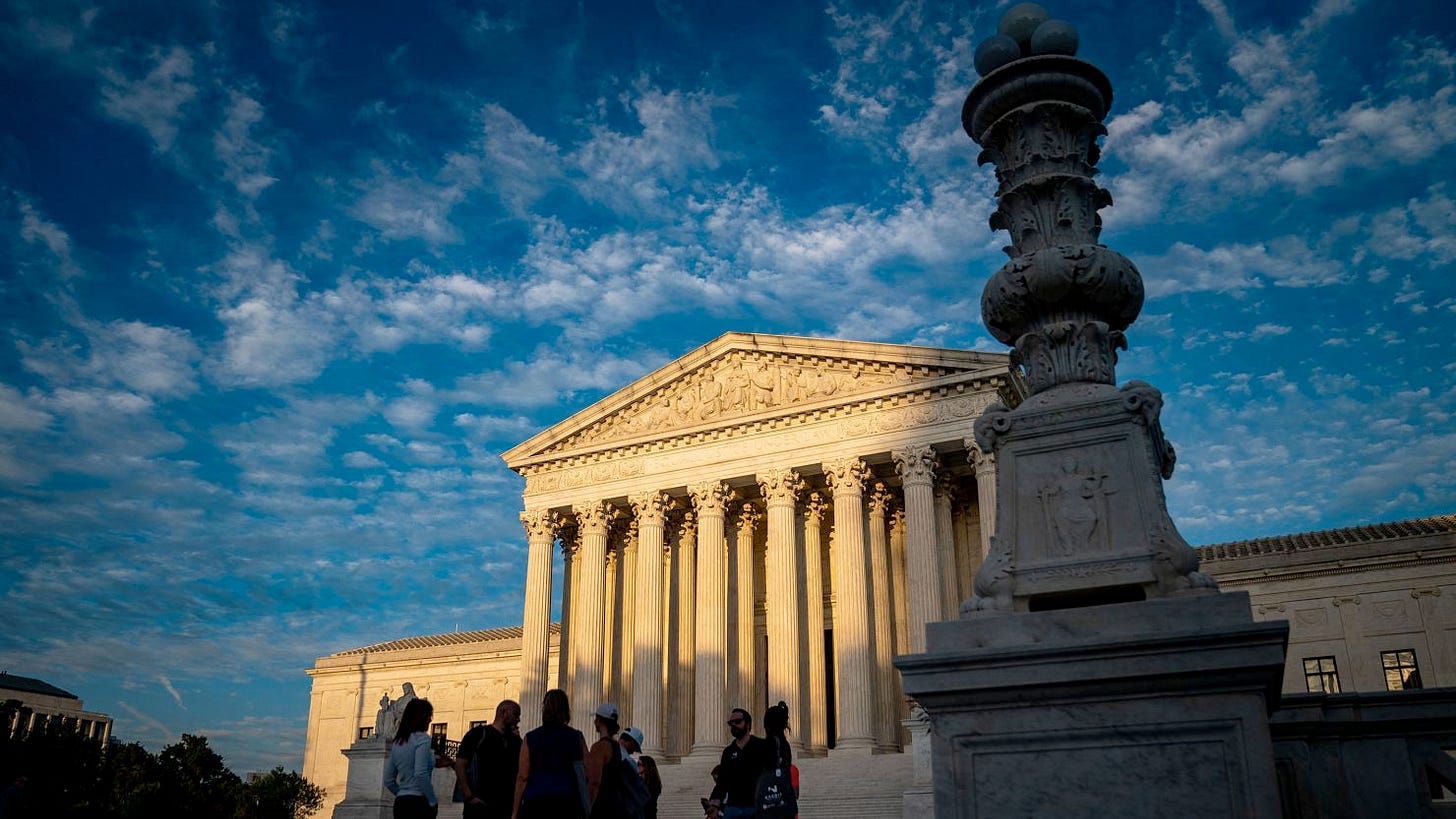Detain Them All: Trump's Interpretation of Immigration Law
Antonia Aguilar Maldonado entered the United States illegally in September 2016, when she was 16 years old.
Like other unaccompanied minors who are caught crossing the border, the El Salvador native was originally placed under the care of the US government before being released to a sponsoring relative.
Over the course of the last nine years, she has continued living in the US while winding her way through various immigration proceedings. Aguilar Maldonado is now 25 years old, married, and living in Minnesota with her husband and their two children, a six-year-old and a 22-month-old.
In July, ICE agents arrested Aguilar Maldonado and her husband as they left home for their work as house painters, initiating an attempt to deport them. After being detained, Aguilar Maldonado asked for bond: to be released from jail while the deportation proceedings were ongoing. She has said that her youngest child still needs to be breastfed due to reflux issues that make it hard for him to digest other types of milk.
In jail, she continued to pump breast milk every day using a pump the jail provided her, although the milk was then discarded. “It breaks my heart to know that my baby needs my breast milk, and that I just have to dump it out,” she said at the time. She also said that her breast milk had started to be tinted green, which she attributed to “acute distress.”
Normally, a bond request like Aguilar Maldonado’s would probably be granted. For decades, the government has used a fairly simple system to decide this:
Immigrants who are arrested immediately upon crossing the border illegally are detained during their deportation proceedings under 8 U.S. Code § 1225, which requires the mandatory detention of unauthorized immigrants “seeking admission” to the US.
Meanwhile, unauthorized immigrants who are arrested after living in the US for years (like Aguilar Maldonado) are usually released from jail under 8 U.S. Code § 1226, which allows for unauthorized immigrants to go free if they don’t pose a flight risk or a danger to their communities.
There are exceptions, including for immigrants who have committed violent crimes since entering the US, but that’s the rule of thumb.
However, the Trump administration fought Aguilar Maldonado’s bond request — and dozens of others like hers. Since July, the administration has sought to upend the status quo, pushing for immigration judges to deny bond to all unauthorized immigrants facing potential deportation, no matter how long they’ve lived here. Earlier this month, the Board of Immigration Appeals (BIA) formalized the policy.
The BIA’s new interpretation was that unauthorized immigrants are all “seeking admission” to the US in one form or another, which means they all fall under 8 U.S. Code § 1225. Therefore, they all must be detained until their deportation case is settled.
ICE detention facilities have swelled as a result, with immigrants being placed in detention irrespective of whether they have a criminal record or how many years they’ve lived in the US. According to The Guardian, there are now more people in ICE detention without a criminal record (16,523) than with one (15,725), although the remaining 13,767 have pending criminal charges.
Per The New York Times, the number of people being granted bond by immigration judges has dropped to an average of 22 per day, down from an average of more than 100 per day before the introduction of the new policy.
Aguilar Maldonado, however, is no longer one of the immigrants facing detention. Despite the government’s efforts, she has been released, after a federal judge ruled against the Trump administration’s new interpretation of the old law.
Judge Susan Richard Nelson found that the government’s “one-size-fits-all” approach to immigrant detention was likely unconstitutional, violating immigrants’ Fifth Amendment rights to due process. She noted that if the administration’s interpretation of 8 US Code § 1225 was correct, it would render 8 US Code § 1226 “utterly superfluous,” since that statute would now be carving out an entirely empty category of people who are eligible for bond.
Taking things one step further, she also noted that President Trump himself signed the Laken Riley Act into law earlier this year, which added to the list of crimes an unauthorized immigrant can commit that earn them mandatory detention. What would have been the point of adding to that list, Nelson pointed out, if it had been Congress’s intent that all unauthorized immigrants be detained in the first place?
Lawyers for the Trump administration, “argue that good public policy reasons support treating aliens appearing at the border the same as those already present in the United States,” Nelson wrote. “However, the law does not currently reflect such public policy considerations. Rather, such arguments may be made to Congress if Respondents would like to amend or repeal §§ 1225 or 1226, but such policy arguments are not reflected in the Laken Riley Act amendments to § 1226(c), passed only a few months ago.”
Judge Nelson is not alone. In fact, Trump’s new policy has fared incredibly poorly when tested in the courts: dozens of federal judges — including appointees of every modern president, Democrat and Republican — have intervened in more than 50 cases to aid unauthorized immigrants the Trump administration is trying to detain under the policy.
Among them is the newest federal judge in the country, Kyle Dudek, who was nominated by President Trump and confirmed by the Senate earlier this month. Just three weeks into his tenure, he ruled against the president who appointed him, siding with Marvin Hernandez Lopez, who has been in the US illegally since 2013 and was denied bond by the Trump administration.
Dudek’s ruling relied on a Supreme Court precedent from 2018 in which the justices seemed to endorse the status quo of treating unauthorized immigrants differently depending on whether they were arrested at the border or already here.
“The Supreme Court’s analysis explains the necessity for both statutes by differentiating between the detention of arriving aliens who are seeking entry into the United States under § 1225, and the detention of those who are already present in the United States under § 1226,” the Trump-appointed jurist wrote.
The president’s move to collapse the two statues into one — the one that detains more unauthorized immigrants — wasn’t going to fly, said Dudek.
This new flurry of detentions highlights the little-known workings of America’s immigration process.
When immigrants here illegally are arrested, their cases are overseen by officials known as “immigration judges,” who might sound like they are jurists in the same way that Nelson or Dudek are. After all, they all have “judge” in their title, right?
But immigration judges, unlike district court or appeals court judges, aren’t subject to Senate confirmation. In fact, despite their title, they aren’t even members of the judicial branch. They are the outgrowth of an odd quirk of our system: in order to execute the law, sometimes the executive branch has to act… judicially, settling disputes that come up in the work of law enforcement, like cases where an immigrant challenges their prospective deportation.
These immigration judges take on a role somewhat similar to that of normal judges — overseeing trial-like proceedings — but they are entirely executive branch appointees, which means their authority (unlike a Supreme Court justice’s, say) flows directly from the president. They are appointed by the attorney general and charged with carrying out the administration’s dictates (though they have to work within the confines of the law, of course).
Like few presidents before him, Trump has taken advantage of this berth the system gives him to set the direction of immigration policy, firing over 80 immigration judges this year, including almost 20 just last week. In the short term, firing these judges would seem to hurt the administration — fewer immigration judges = fewer people who can approve deportations = fewer deportations — but in the long term, it gives the Trump administration more power to change the face of immigration law and stock immigration courts with like-minded appointees.
Last month, the Justice Department changed its policies to allow any attorney to serve as an immigration judge on a temporary basis, replacing a previous restriction that limited the role to attorneys with experience in immigration law. After the change, Defense Secretary Pete Hegseth moved to reassign up to 600 military lawyers as temporary immigration judges.
Decisions by immigration judges can be appealed to the Board of Immigration Appeals, which is also an executive branch body within the Justice Department. Trump has also moved to revamp this board, firing a dozen Biden-era appointees in April. Trump appointees now control a supermajority of the board: nine out of its 13 judges.
This is the reshaped board that recently formalized the new detention policy.
Board of Immigration Appeals rulings can be appealed to the federal courts, which is when most cases have the possibility of exiting the executive branch and entering the judicial branch. Like anyone imprisoned by the US government, immigrants detained in ICE facilities can also file “habeas corpus” petitions (Latin for “you have the body”) to challenge their detention before deportation.
This is the stage of litigation that immigrants like Antonia Aguilar Maldonado have reached. These legal battles show both the impact and the limits of Trump v. CASA, the Supreme Court decision earlier this year ending the ability of district court judges to block administration policies via nationwide injunctions.
Without nationwide injunctions, lawyers defending detained immigrants have mostly had to proceed on a case-by-case basis, meaning they’ve had to score 50+ wins to challenge one policy instead of getting a single judge to strike it down in one fell swoop. Meanwhile, untold other immigrants have to keep on battling, since they receive no benefit from the numerous rulings favoring those in the same position.
But don’t miss where I said “mostly.” Trump v. CASA also left open an enormous loophole in the form of class action suits, and immigrant rights groups are now trying to challenge the Trump policy in that manner, allowing at least for state-by-state — if not nationwide — relief as opposed to case-by-case rulings.
The American Civil Liberties Liberties Union (ACLU) has already filed a nationwide class action suit, as well as statewide suits in Massachusetts and Colorado in the last few weeks.
The cases could ultimately reach the Supreme Court, allowing the justices to decide whether a decades-old interpretation of immigration law — which they themselves appeared to bless not that long ago — will take precedence over Trump’s new attempt to detain as many immigrants as possible.












Gabe, thank you for pulling back the curtain. I hate what I see, but at least now I understand it better.
And the better I understand it, the better I can fight it.
Because that’s the whole point.
I am no longer accepting the things I cannot change - I am changing the things I cannot accept. Angela Davis
Our immigration system is and has been broken for years. It is so offensive that this administration is playing on that brokenness to detain folks who have been living their lives, contributing to their communities and the economy. Now instead of their contributions, we, the remaining tax payers, are paying to confine them. Core Civic and others are certainly lining their pockets from this awful practice.